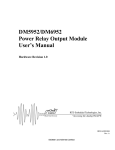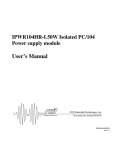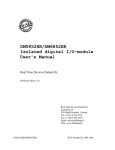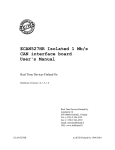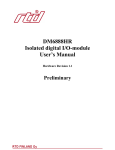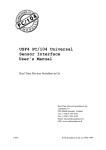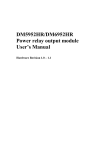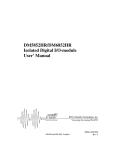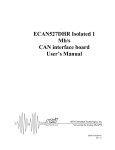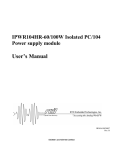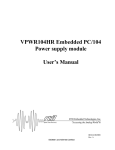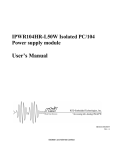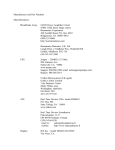Download DM5856/DM6856 Isolated Digital I/O-module User`s Manual
Transcript
DM5856/DM6856 Isolated Digital I/O-module User’s Manual Hardware Revision 1.0 B BDM-610010005 Rev. A ISO9001 and AS9100 Certified DM5856/DM6856 ISOLATED DIGITAL I/O-MODULE User’s Manual RTD Embedded Technologies, INC. 103 Innovation Blvd. State College, PA 16803-0906 Phone: +1-814-234-8087 FAX: +1-814-234-5218 E-mail [email protected] [email protected] web site http://www.rtd.com DM6856 / DM5856 user’s manual -2- RTD Embedded Technologies, Inc. Revision History 20/05/1998 22/03/1999 01/08/1999 Rev. A Release 2.0 Updated and corrected Input optocoupler resistor formula changed New manual naming method Published by: RTD Embedded Technologies, Inc. 103 Innovation Blvd. State College, PA 16803-0906 Copyright 1999, 2002, 2003 by RTD Embedded Technologies, Inc. All rights reserved Printed in U.S.A. The RTD Logo is a registered trademark of RTD Embedded Technologies. cpuModule and utilityModule are trademarks of RTD Embedded Technologies. PhoenixPICO and PheonixPICO BIOS are trademarks of Phoenix Technologies Ltd. PS/2, PC/XT, PC/AT and IBM are trademarks of International Business Machines Inc. MS-DOS, Windows, Windows 95, Windows 98 and Windows NT are trademarks of Microsoft Corp. PC/104 is a registered trademark of PC/104 Consortium. All other trademarks appearing in this document are the property of their respective owners. DM6856 / DM5856 user’s manual -3- RTD Embedded Technologies, Inc. ..................................................................................... ....................................................................................................... TABLE OF CONTENTS CHAPTER 1 INTRODUCTION ............................................................................................6 Features .............................................................................................................................................................................................6 Some of the key features of the DM5856/DM6856 include:..............................................................................................6 Isolated Digital Outputs..........................................................................................................................................................6 Isolated Digital Inputs.............................................................................................................................................................6 Mechanical description...........................................................................................................................................................6 Connector description.............................................................................................................................................................7 What comes with your board..........................................................................................................................................................7 Board accessories ............................................................................................................................................................................7 Using this manual ............................................................................................................................................................................7 CHAPTER 2 BOARD SETTINGS .......................................................................................9 Factory-Configured Jumper Settings ..........................................................................................................................................9 CHAPTER 3 BOARD INSTALLATION ........................................................................... 13 Board Installation.......................................................................................................................................................................... 13 External I/O Connections ............................................................................................................................................................ 15 CHAPTER 4 - HARDWARE DESCRIPTION ................................................................. 17 1. Optocouplers ......................................................................................................................................................................18 2. Input latch...........................................................................................................................................................................18 Isolated digital outputs ................................................................................................................................................................. 19 1. Optocouplers ......................................................................................................................................................................19 2. Output registers .................................................................................................................................................................19 CHAPTER 5 - BOARD OPERATION AND PROGRAMMING..................................... 20 Defining the I/O Map.................................................................................................................................................................... 20 Programming the DM5856......................................................................................................................................................... 21 Clearing and setting bits in an I/O port ..............................................................................................................................21 Isolated Output Programming..............................................................................................................................................22 Isolated Input Programming.................................................................................................................................................22 CHAPTER 6 - DM5856/DM6856 SPECIFICATIONS.................................................... 23 Host Interface................................................................................................................................................................................. 23 Digital Outputs (isolated) ............................................................................................................................................................ 23 Connectors ..................................................................................................................................................................................... 23 Power requirements ..................................................................................................................................................................... 23 Operating temperature range..................................................................................................................................................... 23 CHAPTER 7 RETURN POLICY AND WARRANTY..................................................... 25 DM6856 / DM5856 user’s manual -4- RTD Embedded Technologies, Inc. Return Policy................................................................................................................................................................................. 25 CHAPTER 8 LIMITED WARRANTY................................................................................ 27 List of Illustrations & Tables .................................................................................................................................................................................Illustrations Fig. 2-1 : Board layout showing jumper locations Fig. 3-1 : DM5856/DM6856 integrated in a PC/104 dataModule stack Fig. 3-2 : 19” Eurocard rack installation with an integrated PC/104 data Module and EUROCARD cpuModule computer system Fig. 3-3 : Input connection for Channel number 1 Fig. 3-4 : Output connection for Channel number 1 Fig. 4-1 : DM5856/DM6856 Block Diagram ......................................................................................................................................................................................... Tables Table 2.1 : Factory Jumper settings Table 2.2 : Base Address jumper settings Table 3.1 : Input connection pinouts Table 5.1 : DM5856/DM6856 I/O Map DM6856 / DM5856 user’s manual -5- RTD Embedded Technologies, Inc. Chapter 1 INTRODUCTION This user’s manual describes the operation of the DM5856/DM6856 Isolated Digital Interface boards. Features Some of the key features of the DM5856/DM6856 include: • • • • • • • 16 channel-by-channel isolated open collector digital outputs, 8mA @ 30V 16 optocoupler inputs with reverse voltage protection Single +5V operation RTD IDAN compatible XT (DM5856) and AT (DM6856) boards available Support for direct PC/104 interface with RTD dataModules PC/104 compliant The following paragraphs briefly describe the major features of the DM5856 and DM6856. A more detailed discussion is included in Chapter 3 (Hardware description), and in Chapter 4 (Board operation and programming). The board set-up is described in Chapter 1 (Board Settings). Isolated Digital Outputs 16 optocoupler outputs may be used to directly drive loads such as relays, lamps or interface to commonly encountered 24V PLC I/O's. The outputs are driven with an open collector optocoupler output capable of sinking 8mA at 30V. Each output channel can be connected to a different potential. The isolated outputs are controlled with a latch structure. Isolated Digital Inputs 16 optocoupler inputs may be used to connect high voltage signals to a computer. Eight channel-by-channel isolated input ranges are available. The factory installed input range is +5V, but this input range may be customized channel-by-channel by changing the input series resistors. The optocoupler inputs have a reverse voltage protection diode across the input. This enables AC-connection to the inputs where the input diode acts as a rectifier. Mechanical description The DM5856 is designed on a PC/104 form factor. An easy mechanical interface to both PC/104 and EUROCARD systems can be achieved. Stack your PC/104 compatible computer directly on the DM5856 using the onboard mounting holes. DM6856 / DM5856 user’s manual -6- RTD Embedded Technologies, Inc. Connector description There are two 50 pin digital interface connectors on the DM5856/DM6856 to directly interface isolated digital I/O signals. Isolated inputs and outputs are connected to the board by 50-pin flat ribbon cable header connectors. Use this type of interface connector with a TB50 screw terminal block. What comes with your board Your DM5856/DM6856 package contains the following items: ?? ?? ?? DM5856/DM6856 Isolated Digital Interface module Software and diagnostics diskette with C source code User's manual If any item is missing or damaged, please call Real Time Devices Scandinavia customer service department at the following number :(+358) 9 346 4538. Board accessories In addition to the items included in your DM5856 delivery ,several software and hardware accessories are available .Contact your distributor for more information and for advice on selecting the most appropriate accessories to support your instrumentation system. ?? Application software and drivers. ?? Hardware accessories Real Time Devices can supply a complete set of accessories for your DM5856/DM6856 card. These include: Eurocard enclosures and power supplies, terminal boards (TB50), and other connection systems. The board is also available in the rugged IDAN enclosure system. Please consult the factory for more details or visit our websites at www.rtdscandinavia.fi or www.rtdusa.com. Using this manual This manual is intended to help you install your new board and get it working quickly, while also providing enough detail about the board and it's functions so that you can enjoy maximum use of it's features even in the most demanding applications. DM6856 / DM5856 user’s manual -7- RTD Embedded Technologies, Inc. When you need help This manual and all the example programs will provide you with enough information to fully utilize all the features on this board. If you have any problems with installation or use of the board, contact our Technical Support Department (+358) 9 346 4538 during European business hours. Alternatively, send a FAX to (+358) 9 346 4539, or Email to: [email protected]. When sending a FAX or Email request please include the following information: Your company's name and address, your name, your telephone number, and a brief description of the problem. DM6856 / DM5856 user’s manual -8- RTD Embedded Technologies, Inc. Chapter 2 BOARD SETTINGS The DM5856/DM6856 Isolated digital I/O board has jumper settings which can be changed to suit your application. It is factory configured with a +5V input range configuration. The factory settings are listed and shown in the diagram in the beginning of this chapter. Factory-Configured Jumper Settings Table 2-1 below illustrates the factory jumper setting for the DM5856/DM6856. It also shows the board layout of the DM5856/DM5856 and the locations of the jumpers. The following paragraphs explain how to change the factory jumper settings to suit your specific application. Table 2-1: Factory jumper settings (see figure 2-1 below for detailed locations) Jumper name Jumper description Number of Jumpers Factory setting jumpers installed Base address Base address 8 300h DM6856 / DM5856 user’s manual -9- RTD Embedded Technologies, Inc. Figure 2-1 - Board layout showing jumper locations (Figure shows DM6856 board) DM6856 / DM5856 user’s manual - 10 - RTD Embedded Technologies, Inc. Base address Jumpers (Factory setting :300h) The most common cause of failure when you are first setting up your module is address contention Some of your computers I/O space is already occupied by other internal I/O devices and expansion boards. When the board attempts to use it's own reserved I/O addresses (which are being already used by another peripheral device), erratic performance may occur and the data read from the board may be corrupted. To avoid this problem make sure you set up the base address first using the eight jumpers marked "BASE ADDRESS”. It allows you to choose from 256 different I/O addresses in your computer I/O map. Should the factory installed setting of 300h be unusable for your system configuration, you may change this setting to another using the options illustrated in Table 2-2 (overleaf). The table shows the switch settings and their corresponding values in hexadecimal values. Ensure that you verify the correct location of the base address jumpers. When the jumper is removed it corresponds to a logical "0", connecting the jumper to a "1". When you set the base address of the module, record the setting inside the back cover of this manual (directly after the Appendices). BASE ADDRESS JUMPER SETTINGS FOR DM5856/DM6858 BOARDS Base address Hex / (Decimal) Jumper Settings 87654321 Base Address Hex / (Decimal) Jumper settings 87654321 200 / (512) 210 / (528) 220 / (544) 230 / (560) 240 / (576) 250 / (592) 260 / (608) 270 / (624) 280 / (640) 290 / (656) 2A0 / (672) 2B0 / (688) 2C0 / (704) 2D0 / (720) 2E0 / ( 736) 2F0 / (752) 00000 00001 00010 00011 00100 00101 00110 00111 01000 01001 01010 01011 01100 01101 01110 01111 300 / (768) 310 / (784) 320 / (800) 330 / (816) 340 / (832) 350 / (848) 360 / (864) 370 / (880) 380 / (896) 390 / (912) 3A0 / (928) 3B0 / (944) 3C0 / (960) 3D0 / (976) 3E0 / (922) 3F0 / (1008) 10000 10001 10010 10011 10100 10101 10110 10111 11000 11001 11010 11011 11100 11101 1 1110 11111 1 = NOT JUMPERED, 0 = JUMPER INSTALLED Table 2-2 : Base Address Jumper settings , factory default Base Address shaded Note: In the table above only the MSB address decoder jumper settings are illustrated. You may also connect jumpers 1-3 to decode address lines A1-A3 DM6856 / DM5856 user’s manual - 11 - RTD Embedded Technologies, Inc. DM6856 / DM5856 user’s manual - 12 - RTD Embedded Technologies, Inc. Chapter 3 BOARD INSTALLATION The DM5856/DM6856 Isolated Digital Interface board is very easy to connect to your industrial or automotive control system. Direct interface to PC/104 systems as well as EUROCARD boards is possible. This chapter gives step-bystep instructions on how to install the board into your system. After completing the installation it is recommended that you use the diagnostic software “diag5856.exe” to fully verify that your board is working. Board Installation Keep your board in the antistatic bag until you are ready to install it to your system! When removing it from the bag, hold the board at the edges and do not touch the components or connectors. Ple ase handle the board in an antistatic environment and use a grounded workbench for testing and handling of your hardware. Before installing the board in your computer, check the jumper settings .Chapter 1 reviews the factory settings and how to alter them. If any alterations are needed please refer to the appropriate instructions in this chapter. Do however note that incompatible settings can result in unpredictable board operation and erratic response. General installation guidelines: ?? Turn OFF the power to your computer ?? Touch the grounded metal housing of your computer to discharge any antistatic build-up and then remove the board from its antistatic bag. ?? Hold the board by the edges and install it in an enclosure or place it on the able on an antistatic surface. ?? Connect the board to the I/O devices using the twisted pair 50-pin flat cable Fig. 3-1: DM5856/DM6856 integrated in a PC/104 RTD cpuModule stack DM6856 / DM5856 user’s manual - 13 - RTD Embedded Technologies, Inc. 3U rack or enclosure installation with a EUROCARD CPU with one DM5856 The PC/104 system can easily be inserted into a 19" rack installation using the CPU as a "form factor adapter". Assemble your PC/104 data modules on a RTD single board EUROCARD computer and install the system in a 19" enclosure. Multiple DM5856 boards can be easily connected to this system. See figure 3-2 below. Fig 3-2: 19” Eurocard rack installation with an integrated PC/104 dataModule and EUROCARD cpuModule computer system DM6856 / DM5856 user’s manual - 14 - RTD Embedded Technologies, Inc. External I/O Connections Table 3-1 below shows the input wire connection pinouts. PIN number 1 Signal Description + IN1 PIN Number 2 Signal Description - IN1 + IN2 3 NC 4 5 - IN2 6 NC 7 + IN3 8 - IN3 + IN4 9 NC 10 11 - IN4 12 13 + IN5 14 - IN5 15 NC 16 + IN6 17 - IN6 18 NC 19 + IN7 20 - IN7 21 NC 22 +IN8 23 - IN8 24 NC 25 + IN9 26 -IN9 27 NC 28 +IN10 29 - IN10 30 NC 31 + IN11 32 -IN11 33 NC 34 +IN12 35 - IN12 36 NC 37 + IN13 38 -IN13 39 NC 40 +IN14 41 - IN14 42 NC 43 + IN15 44 -IN15 45 NC 46 +IN16 47 - IN16 48 NC 49 NC 50 NC NC Fig: 3-3 : This diagram illustrates the input connection for Channel number 1 DM6856 / DM5856 user’s manual - 15 - RTD Embedded Technologies, Inc. Table 3-2 below shows the output connection pinouts Pin number 1 3 5 7 9 11 13 15 17 19 21 23 25 27 29 31 33 35 37 39 41 43 45 47 49 Signal description +Vsupply-1 GND-1 Out2 +Vsupply-3 GND-3 Out4 +Vsupply-5 GND-5 Out6 +Vsupply-7 GND-7 Out8 +Vsupply-9 GND-9 Out10 +Vsupply-11 GND-11 Out12 +Vsupply-13 GND-13 Out14 +Vsupply-15 GND-15 Out16 NC Pin number 2 4 6 8 10 12 14 16 18 20 22 24 26 28 30 32 34 36 38 40 42 44 46 48 50 Signal Description Out1 +Vsupply-2 GND-2 Out3 +Vsupply-4 GND-4 Out5 +Vsupply-6 GND-6 Out7 +Vsupply-8 GND-8 Out9 +Vsupply-10 GND-10 Out11 +Vsupply-12 GND-12 Out13 +Vsupply-14 GND-14 Out15 +Vsupply-16 GND-16 NC 3-4: This diagram illustrates the output connection for Channel number 1 DM6856 / DM5856 user’s manual - 16 - RTD Embedded Technologies, Inc. Chapter 4 - HARDWARE DESCRIPTION This chapter describes in detail the two major features of the DM5856/DM6856: The isolated optocoupler inputs and the isolated optocoupler outputs. Fig 4-1: DM5856/DM6856 Block Diagram DM6856 / DM5856 user’s manual - 17 - RTD Embedded Technologies, Inc. Isolated digital inputs The Isolated output stage of the DM5856 consists of two major parts: 1. Optocouplers 2. Input latch 1. Optocouplers Small SMD optocouplers are used to isolate each channel of the isolated inputs. Individual optocouplers are used for each channel. The optocouplers are directly connected to the input latch in an inverting configuration. A reverse voltage protection diode is connected across the optocoupler input. The input voltage range can be customized by changing the input series resistor channel-by-channel. The factory preinstalled input voltage is +5V (or TTL). The threshold voltage is approximately 3,2 to 3,4V. To customize the input range to a different one please change the input resistor. The nominal value of the +5V range input resistor is 1 KOhm. The forward voltage of the optocoupler is 1,25 - 1,7V. The triggering current is about 0.5mA. This for example if you require a 24V input range you need to calculate the series resistor as follows: Nominal input voltage: 24V Trigger voltage 20V Forward current at 20V 0.5mA Diode forward voltage drop 1,7V Series resistor ???? Formula: (could be set to something else too) (20V-1,7V) / 0.5mA = Rs => Rs = 36.6 KOhms ( Round to 37K ) The absolute maximum forward current of the optocoupler is 20mA , ie. the maximum allowed voltage with the factory set +5V range is 18V! 2. Input latch The inverting optocouplers are connected to two 8-bit data latches that are directly addressable with a read operation at address BASE+0 and BASE+1. DM6856 / DM5856 user’s manual - 18 - RTD Embedded Technologies, Inc. Isolated digital outputs The Isolated input stage of the DM5856/DM6856 consists of two major parts: 1. Optocouplers 2. Output registers 1. Optocouplers Small SMD optocouplers are used to isolate each channel of the isolated outputs. Individual optocouplers are used for each channel. The optocouplers are directly connected to the Output latch. The output optocoupler transistor is in the open collector configuration with a pull-up resistor which is connected to the collector. A 4,7 KOhm resistor is used as a pull-up to the supply. The output 4.7 Kohm pull-up resistor has been installed for a +5 - 30V isolated output range. 2. Output registers The optocouplers are connected to two 8-bit data registers which are directly addressable with a write operation at address BASE+0 and BASE+1. The state of the outputs does not change even though a system reset may occur. Only a software write to the output latch will update the output state. DM6856 / DM5856 user’s manual - 19 - RTD Embedded Technologies, Inc. Chapter 5 - BOARD OPERATION AND PROGRAMMING This chapter shows you how to program and use your DM5856/DM6856: It provides a complete description of the I/O-map plus a detailed discussion of programming operations to aid you in programming. Defining the I/O Map The I/O map of the DM5856/DM6856 is shown in Table 5-1 below. As shown ,the module occupies two addresses. The Base Address (designated as BA) can be set using the jump ers as described in Chapter 2 (Board settings). The following sections describe the register contents of each address used in the I/O map. Table 5-1: DM5856/DM6856 I/O Map Register Description Low Byte (ch. 1-8) High Byte (ch. 9-16) Read Function Digital Inputs 1-8 Digital Inputs 9-16 Write Function Digital outputs 1-8 Digital outputs 9-16 Address in HEX BA+0 BA+1 BA = Base Address BA+0 Digital Inputs 1-8 (Read ) The optoisolated digital input channels 1-8 can be read from address BA+0. BA+1 Digital Inputs 9-16 (Read ) The optoisolated digital input channels 9-16 can be read from address BA+1. BA+0 Digital Outputs (Write) The Data Output register controls the output optocouplers 1-8. Data is transferred from the Data regis ter to the outputs by performing an 8-bit write to BA+0. Direct transfer of data to the output latch for all 16 bits can be performed by executing a 16-bit write to BA+0. The address decoder of the DM5856 will automatically write consecutive addresses BA+0 and BA+1with the correct output data bytes. BA+1 Digital Outputs (Write) The Data Output register controls the output optocouplers 9-16. Data is transferred from the Data register to the outputs by performing an 8-bit write to BA+1. DM6856 / DM5856 user’s manual - 20 - RTD Embedded Technologies, Inc. Programming the DM5856 This section gives you some general information about programming the DM5856 board. It then walks you through the major programming functions of the DM5856. This will help you use the example program that is included with the board. All of the program descriptions use decimal values unless otherwise specified. The DM5856 is programmed by writing to, and reading from, the correct I/O-port addresses of the board. These I/O ports were described in the previous section of this chapter. The following example shows how to perform a 8bit read and write I/O port addresses using "C"-syntax and assembly code: Read: Write: "C"-syntax var = inp(address); outp(address,data); Assembly mov dx,address in ax,dx mov dx,address mov ax,data out dx,ax 8-bit operations must be performed to the DM5856/DM6856 board for correct operation. Clearing and setting bits in an I/O port When you clear or set bits in an I/O port you must be careful not to alter the status of other bits. You can preserve the status of all the bits you do not wish to change by proper use of the bitwise AND- and ORoperators. Using and /or operators, single or multiple bits can easily be set or cleared in one line operations. 1. To clear a single bit in a port, AND the current value of the port with the value "B" , where B = 255-2(exp) bit. 2. To set a single bit in a port, OR the current value of the port with the value "B", where B = 2(exp) bit. Bits are numbered from 0-7 for the low byte of a word and from 8-15 for the high byte of a word. Setting and clearing of multiple bits in a bye or word is more complex. 3. To clear multiple bits in a port, AND the current value of the port with the value "B", where B = 255 - (the sum of the values of the bits to be cleared). Note that the bits do not have to be consecutive. 4. To set multiple bits in a port, OR the current value of the port with the value "B", where B = (sum of the individual bits to be set). DM6856 / DM5856 user’s manual - 21 - RTD Embedded Technologies, Inc. Isolated Output Programming The optoisolated outputs are controlled with a register structure. These outputs can be commanded in the following ways ( examples in "C" syntax): 1. Software controlled byte write outp(BA,low_byte); outp(BA,high_byte); 2. Software controlled direct word write outpw(BA,word); Isolated Input Programming The optoisolated inputs are read from a data latch. These inputs can be interrogated in the following ways (examples in "C" syntax): 1. Software controlled byte read low_data = inp(BA); high_data = inp(BA+1); 2. Software controlled direct word read word_data = inpw(BA); DM6856 / DM5856 user’s manual - 22 - RTD Embedded Technologies, Inc. Chapter 6 - DM5856/DM6856 SPECIFICATIONS Host Interface Jumper selectable base address, I/O mapped Digital Outputs (isolated) Number of lines Isolation voltage Output stage 16 1.500V Rms Open collector with 4,8K pull-up 8 mA sink current , 30V +5 to +30V Output supply voltage Digital Inputs (isolated) Number of lines Triggering voltage +5V range Maximum input voltage factry default +5V range Isolation voltage 16 3,3V (Approx.) 18V 1.500V Rms. Connectors Isolated Outputs Isolated Inputs Bus connector 50 pin header connector 50 pin header connector PC/104 XT or AT-connector Power requirements Supply voltage +5V +/- 8% Supply current 125 mA Operating temperature range Standard Extended DM6856 / DM5856 user’s manual -0 to +70 C -40 to +85 C - 23 - RTD Embedded Technologies, Inc. DM6856 / DM5856 user’s manual - 24 - RTD Embedded Technologies, Inc. Chapter 7 RETURN POLICY AND WARRANTY Return Policy If you wish to return a product to the factory for service, please follow this procedure: Read the Limited Warranty to familiarize yourself with our warranty policy. Contact the factory for a Return Merchandise Authorization (RMA) number. Please have the following available: • • • Complete board name Board serial number A detailed description of the board’s behavior List the name of a contact person, familiar with technical details of the problem or situation, along with their phone and fax numbers, address, and e-mail address (if available). List your shipping address!! Indicate the shipping method you would like used to return the product to you. We will not ship by next-day service without your pre-approval. Carefully package the product, using proper anti-static packaging. Write the RMA number in large (1") letters on the outside of the package. Return the package to: RTD Embedded Technologies, Inc. 103 Innovation Blvd. State College PA 16803-0906 USA DM6856 / DM5856 user’s manual - 25 - RTD Embedded Technologies, Inc. DM6856 / DM5856 user’s manual - 26 - RTD Embedded Technologies, Inc. Chapter 8 LIMITED WARRANTY RTD Embedded Technologies, Inc. warrants the hardware and software products it manufactures and produces to be free from defects in materials and workmanship for one year following the date of shipment from RTD Embedded Technologies, INC. This warranty is limited to the original purchaser of product and is not transferable. During the one year warranty period, RTD Embedded Technologies will repair or replace, at its option, any defective products or parts at no additional charge, provided that the product is returned, shipping prepaid, to RTD Embedded Technologies. All replaced parts and products become the property of RTD Embedded Technologies. Before returning any product for repair, customers are required to contact the factory for an RMA number. THIS LIMITED WARRANTY DOES NOT EXTEND TO ANY PRODUCTS WHICH HAVE BEEN DAMAGED AS A RESULT OF ACCIDENT, MISUSE, ABUSE (such as: use of incorrect input voltages, improper or insufficient ventilation, failure to follow the operating instructions that are provided by RTD Embedded Technologies, "acts of God" or other contingencies beyond the control of RTD Embedded Technologies), OR AS A RESULT OF SERVICE OR MODIFICATION BY ANYONE OTHER THAN RTD Embedded Technologies. EXCEPT AS EXPRESSLY SET FORTH ABOVE, NO OTHER WARRANTIES ARE EXPRESSED OR IMPLIED, INCLUDING, BUT NOT LIMITED TO, ANY IMPLIED WARRANTIES OF MERCHANTABILITY AND FITNESS FOR A PARTICULAR PURPOSE, AND RTD Embedded Technologies EXPRESSLY DISCLAIMS ALL WARRANTIES NOT STATED HEREIN. ALL IMPLIED WARRANTIES, INCLUDING IMPLIED WARRANTIES FOR MECHANTABILITY AND FITNESS FOR A PARTICULAR PURPOSE, ARE LIMITED TO THE DURATION OF THIS WARRANTY. IN THE EVENT THE PRODUCT IS NOT FREE FROM DEFECTS AS WARRANTED ABOVE, THE PURCHASER'S SOLE REMEDY SHALL BE REPAIR OR REPLACEMENT AS PROVIDED ABOVE. UNDER NO CIRCUMSTANCES WILL RTD Embedded Technologies BE LIABLE TO THE PURCHASER OR ANY USER FOR ANY DAMAGES, INCLUDING ANY INCIDENTAL OR CONSEQUENTIAL DAMAGES, EXPENSES, LOST PROFITS, LOST SAVINGS, OR OTHER DAMAGES ARISING OUT OF THE USE OR INABILITY TO USE THE PRODUCT. SOME STATES DO NOT ALLOW THE EXCLUSION OR LIMITATION OF INCIDENTAL OR CONSEQUENTIAL DAMAGES FOR CONSUMER PRODUCTS, AND SOME STATES DO NOT ALLOW LIMITATIONS ON HOW LONG AN IMPLIED WARRANTY LASTS, SO THE ABOVE LIMITATIONS OR EXCLUSIONS MAY NOT APPLY TO YOU. THIS WARRANTY GIVES YOU SPECIFIC LEGAL RIGHTS, AND YOU MAY ALSO HAVE OTHER RIGHTS WHICH VARY FROM STATE TO STATE. DM6856 / DM5856 user’s manual - 27 - RTD Embedded Technologies, Inc. RTD Embedded Technologies, Inc. 103 Innovation Blvd. State College PA 16803-0906 USA Our website: www.rtd.com DM6856 / DM5856 user’s manual - 28 - RTD Embedded Technologies, Inc.




























